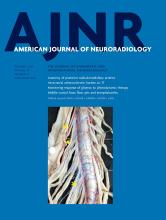Research ArticleNeurointervention
Open Access
How Flow Reduction Influences the Intracranial Aneurysm Occlusion: A Prospective 4D Phase-Contrast MRI Study
O. Brina, P. Bouillot, P. Reymond, A.S. Luthman, C. Santarosa, M. Fahrat, K.O. Lovblad, P. Machi, B.M.A. Delattre, V.M. Pereira and M.I. Vargas
American Journal of Neuroradiology December 2019, 40 (12) 2117-2123; DOI: https://doi.org/10.3174/ajnr.A6312
O. Brina
aFrom the Divisions of Neuroradiology (O.B., P.R., A.S.L., C.S., K.O.L., P.M., V.M.P., M.I.V.)
P. Bouillot
cDepartment of Quantum Matter Physics (P.B.), University of Geneva, Geneva, Switzerland
P. Reymond
aFrom the Divisions of Neuroradiology (O.B., P.R., A.S.L., C.S., K.O.L., P.M., V.M.P., M.I.V.)
A.S. Luthman
aFrom the Divisions of Neuroradiology (O.B., P.R., A.S.L., C.S., K.O.L., P.M., V.M.P., M.I.V.)
C. Santarosa
aFrom the Divisions of Neuroradiology (O.B., P.R., A.S.L., C.S., K.O.L., P.M., V.M.P., M.I.V.)
M. Fahrat
dLaboratory for Hydraulic Machines (M.F.), Ecole Polytechnique Fédérale de Lausanne, Lausanne, Switzerland
K.O. Lovblad
aFrom the Divisions of Neuroradiology (O.B., P.R., A.S.L., C.S., K.O.L., P.M., V.M.P., M.I.V.)
P. Machi
aFrom the Divisions of Neuroradiology (O.B., P.R., A.S.L., C.S., K.O.L., P.M., V.M.P., M.I.V.)
B.M.A. Delattre
bRadiology (B.M.A.D.), Geneva University Hospitals, University of Geneva, Geneva, Switzerland
V.M. Pereira
aFrom the Divisions of Neuroradiology (O.B., P.R., A.S.L., C.S., K.O.L., P.M., V.M.P., M.I.V.)
eDivision of Neuroradiology (V.M.P.)
fDepartment of Medical Imaging (V.M.P.)
gDivision of Neurosurgery (V.M.P.), Department of Surgery, Toronto Western Hospital, University Health Network, Toronto, Ontario, Canada.
M.I. Vargas
aFrom the Divisions of Neuroradiology (O.B., P.R., A.S.L., C.S., K.O.L., P.M., V.M.P., M.I.V.)

References
- 1.↵
- Becske T,
- Kallmes DF,
- Saatci I, et al
- 2.↵
- 3.↵
- Brinjikji W,
- Murad MH,
- Lanzino G, et al
- 4.↵
- 5.↵
- 6.↵
- 7.↵
- 8.↵
- Szikora I,
- Marosfoi M,
- Salomvary B, et al
- 9.↵
- Chalouhi N,
- Tjoumakaris S,
- Starke RM, et al
- 10.↵
- Di Maria F,
- Pistocchi S,
- Clarencon F, et al
- 11.↵
- Delgado Almandoz JE,
- Kayan Y,
- Tenreiro A, et al
- 12.↵
- Ikeda H,
- Ishii A,
- Kikuchi T, et al
- 13.↵
- Kulcsar Z,
- Houdart E,
- Bonafe A, et al
- 14.↵
- Pereira VM,
- Bonnefous O,
- Ouared R, et al
- 15.↵
- Chien A,
- Vinuela F.
- 16.↵
- Kulcsar Z,
- Augsburger L,
- Reymond P, et al
- 17.↵
- Mut F,
- Raschi M,
- Scrivano E, et al
- 18.↵
- 19.↵
- Wu C,
- Ansari SA,
- Honarmand AR, et al
- 20.↵
- 21.↵
- Karmonik C,
- Anderson JR,
- Elias S, et al
- 22.↵
- 23.↵
- 24.↵
- 25.↵
- Ouared R,
- Larrabide I,
- Brina O, et al
- 26.↵
- 27.↵
- 28.↵
- Rouchaud A,
- Ramana C,
- Brinjikji W, et al
- 29.↵
- Kadirvel R,
- Ding YH,
- Dai D, et al
- 30.↵
- Marosfoi M,
- Langan ET,
- Strittmatter L, et al
- 31.↵
- 32.↵
- 33.↵
- 34.↵
- 35.↵
- Bouillot P,
- Brina O,
- Yilmaz H, et al
- 36.↵
- 37.↵
- Chalouhi N,
- Tjoumakaris S,
- Phillips JL, et al
- 38.↵
- 39.↵
- 40.↵
- Gester K,
- Luchtefeld I,
- Busen M, et al
In this issue
American Journal of Neuroradiology
Vol. 40, Issue 12
1 Dec 2019
Advertisement
O. Brina, P. Bouillot, P. Reymond, A.S. Luthman, C. Santarosa, M. Fahrat, K.O. Lovblad, P. Machi, B.M.A. Delattre, V.M. Pereira, M.I. Vargas
How Flow Reduction Influences the Intracranial Aneurysm Occlusion: A Prospective 4D Phase-Contrast MRI Study
American Journal of Neuroradiology Dec 2019, 40 (12) 2117-2123; DOI: 10.3174/ajnr.A6312
0 Responses
How Flow Reduction Influences the Intracranial Aneurysm Occlusion: A Prospective 4D Phase-Contrast MRI Study
O. Brina, P. Bouillot, P. Reymond, A.S. Luthman, C. Santarosa, M. Fahrat, K.O. Lovblad, P. Machi, B.M.A. Delattre, V.M. Pereira, M.I. Vargas
American Journal of Neuroradiology Dec 2019, 40 (12) 2117-2123; DOI: 10.3174/ajnr.A6312
Jump to section
Related Articles
Cited By...
- No citing articles found.
This article has not yet been cited by articles in journals that are participating in Crossref Cited-by Linking.
More in this TOC Section
Similar Articles
Advertisement











